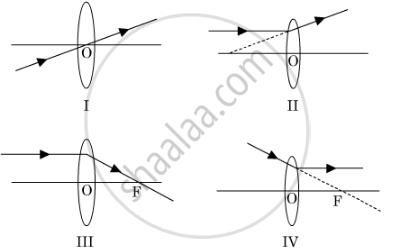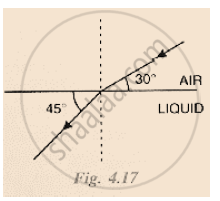Advertisements
Advertisements
Question
Find the nature, position and magnification of the images formed by a convex lens of focal length 0.20 m if the object is placed at a distance of:
0.50 m
Solution
u =-0.50 m = -50 cm
f = 0.20 m = 20 cm
Lens formula:
`1/f=1/v-1/u`
⇒`1/20=1/v-1/-50`
⇒`1/v=1/20-1/50`
⇒`1/v=(5-2)/100`
⇒`1/v=3/100`
⇒`v=100/3` cm
The image will be at a distance of 33.3 cm on the right side of the mirror
magnification `m=v/u`
`m=33.3/-50`
`m=-0.66`
magnification is negative therefore image will be real and inverted.
APPEARS IN
RELATED QUESTIONS
A student has obtained a magnified image of a flame on a screen using a convex lens. To draw the corresponding ray diagram to show the image formation, which of the following two rays whose paths after refraction are shown, should he select ?

(A) I and II
(B) II and III
(C) III and IV
(D) I and III
A ray of light travelling in air is incident on a parallel-sided glass slab (or rectangular glass slab). Draw a ray-diagram indicating the change in its path in glass.
A 1 cm high object is placed at a distance of 2f from a convex lens. What is the height of the image formed?
With the help of a labelled diagram explain how a convex lens converges a beam of parallel light rays. Mark the principal axis, optical centre, principal focus and focal length of the convex lens on the diagram.
What kind of lens is used to correct
long-sightedness?
The diagram alongside shows the refraction of a ray of light from sir to a liquid.
(a) write the values of (i) angle of incidence, (ii) angle of refraction.
(b) use snell’s law to find the refractive index of liquid with respect to air.

A light ray does not bend at the boundary in passing from one medium to the other medium if the angle of incident is:
State two applications of a convex lens.
A lens always forms an image between the object and the lens.
A lens always forms an image between the object and the lens.
Which of the following statements is true?
